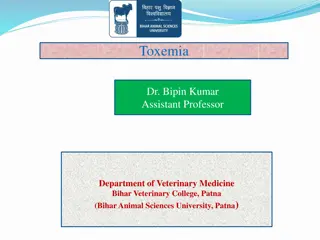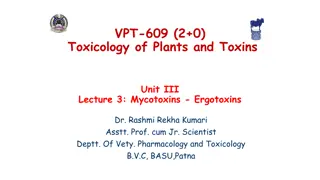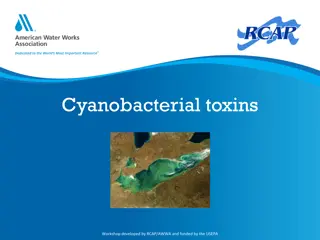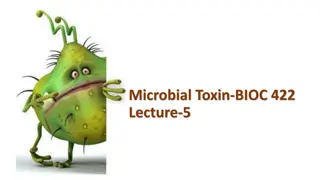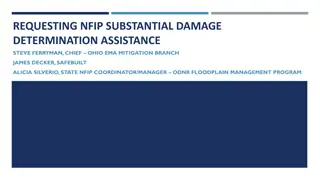Understanding Bacterial Toxins and Cell Damage
Bacterial toxins are poisonous substances produced by microbes that can cause harm to host cells through direct damage, toxin production, and hypersensitivity reactions. Toxigenesis is a crucial mechanism used by bacterial pathogens to induce disease, with endotoxins and exotoxins playing distinct roles in cellular damage. Knowing how bacterial toxins operate is essential in comprehending the pathogenicity of various bacteria.
Download Presentation

Please find below an Image/Link to download the presentation.
The content on the website is provided AS IS for your information and personal use only. It may not be sold, licensed, or shared on other websites without obtaining consent from the author. Download presentation by click this link. If you encounter any issues during the download, it is possible that the publisher has removed the file from their server.
E N D
Presentation Transcript
A toxin is a poisonous substance produced within living cells or organisms. toxins can be small molecules, peptides, or proteins that are capable of causing disease on contact with or absorption by body tissues interacting with biological macromolecules such as enzymes or cellular receptors. Toxins were the first bacterial virulence factors to be identified and were also the first link between bacteria and cell biology. 2
How Bacterial Cells Damage Host Cells O Host cell damages caused by three mechanisms: 1. Direct Damage 2. Toxins 3. Hypersensitivity Reactions * Most bacterial damage is carried out by toxins. 3
O 1. Direct Damage O Some bacteria can induce cells to engulf them (E. coli, Shigella, Salmonella, and Neisseria gonorrhoeae). O Microbial metabolism and multiplication kills host cells. O Other microbes enter the cell by excreting enzymes or through their own motility. 4
2. Toxin Production O Toxins: Poisonous substances produced by microbes. O Frequently toxins are the main pathogenic factor. O Toxigenicity: Ability of a microbe to produce toxins. O Toxemia: Presence of toxins in the blood. O Toxin effects: May include fever, cardiovascular problems, diarrhea, shock, destruction of red blood cells and blood vessels, and nervous system disruptions. O Of 220 known bacterial toxins, 40% damage eucaryotic cell membranes. 5
Bacterial Toxigenesis Toxigenesis, or the ability to produce toxins, is an underlying mechanism by which many bacterial pathogens produce disease. At a chemical level, there are two main types of bacterial toxins, lipopolysaccharides, which are associated with the cell wall of Gram-negative bacteria, and proteins, which are released from bacterial cells and may act at tissue sites removed from the site of bacterial growth. The cell-associated toxins are referred to as endotoxins and the extracellular diffusible toxins are referred to as exotoxins. 7
Endotoxins are cell-associated substances that are structural components of bacteria. Most endotoxins are located in the cell envelope. In the context of this article, endotoxin refers lipopolysaccharide (LPS) or lipooligosaccharide (LOS) located in the outer membrane of Gram-negative bacteria. Although structural components of cells, soluble endotoxins may be released from growing bacteria or from cells that are lysed as a result of effective host defense mechanisms or by the activities of certain antibiotics. Endotoxins generally act in the vicinity of bacterial growth or presence. specifically to the 8
Exotoxins are usually secreted by bacteria and act at a site removed from bacterial growth. However, in some cases, exotoxins are only released by lysis of the bacterial cell. Exotoxins are usually polypeptides, that act enzymatically or through direct action with host cells and stimulate a variety of host responses. Most exotoxins act at tissue sites remote from the original point of bacterial invasion or growth. However, some bacterial exotoxins act at the site of pathogen colonization and may play a role in invasion. proteins, minimally 9
Two types of bacterial toxins 1.Lipopolysaccharides: areassociated with the cell walls of Gram-ve bacteria. The lipopolysaccharide (LPS) component of the Gram-ve bacterial outer membrane bears the name endotoxin because of its association with the cell wall of bacteria. 10
O 2.Proteins: may be released into the extracellular environment of pathogenic bacteria. Most of the protein toxins are thought of as exotoxins, since they are "released" from the bacteria and act on host cells at a distance 11
O Bacterial protein toxins Exotoxins are usually secreted by living bacteria during exponential growth. The production of the toxin is generally specific to a particular bacterial species that produces the disease associated with the toxin (e.g. only Clostridium tetani produces tetanus toxin; only Corynebacterium diphtheriae produces the diphtheria toxin). Usually, virulent strains of the bacterium produce the toxin while nonvirulent strains do not, and the toxin is the major determinant of virulence (e.g. tetanus and diphtheria). At one time, it was thought that exotoxin production was limited mainly to Gram-positive bacteria, but clearly both Gram-positive and Gram-negative bacteria produce soluble protein toxins. - Bacterial protein toxins are the most powerful human poisons known and retain high activity at very high dilutions. 13
Usually the site of damage caused by an exotoxin indicates the location for activity of that toxin. Terms such as enterotoxin, neurotoxin, leukocidin or hemolysin are descriptive terms that indicate the target site of some well-defined protein toxins. A few bacterial toxins that obviously bring about the death of an animal are known simply as lethal toxins, and even though the tissues affected and the target site or substrate may be known, the precise mechanism by which death occurs is not clear (e.g. anthrax LF). - Some bacterial toxins are utilized as invasins because they act locally to promote bacterial invasion. Examples are extracellular enzymes that degrade tissue matrices or fibrin, allowing the bacteria to spread. This includes collagenase, hyaluronidase and streptokinase. Other toxins, also considered invasins, degrade membrane components, such as phospholipases and lecithinases. - 14
O - The pore-forming toxins that insert a pore into eucaryotic membranes are considered as invasins, as well, but they will be reviewed here. - Some protein toxins have very specific cytotoxic activity (i.e., they attack specific types of cells). For example, tetanus and botulinum toxins attack only neurons. But some toxins (as produced by staphylococci, streptococci, clostridia, etc.) have fairly broad cytotoxic activity and cause nonspecific death of various types of cells or damage to tissues, eventually resulting in necrosis. Toxins that are phospholipases act in this way. This is also true of pore-forming hemolysins and leukocidins. 15
- Bacterial protein toxins are strongly antigenic. In vivo, specific antibody neutralizes the toxicity of these bacterial exotoxins (antitoxin). However, in vitro, specific antitoxin may not fully inhibit their activity. This suggests that the antigenic determinant of the toxin may be distinct from the active portion of the protein molecule. The degree of neutralization of the active site may depend on the distance from the antigenic site on the molecule. However, since the toxin is fully neutralized in vivo, this suggests that other host factors must play a role in toxin neutralization in nature. Protein exotoxins are inherently unstable. In time they lose their toxic properties but retain their antigenic ones. This was first discovered by Ehrlich who coined the term "toxoid" for this product. 16
-Toxoids are detoxified toxins which retain their antigenicity and their immunizing capacity. The formation of toxoids can be accelerated by treating toxins with a variety of reagents including formalin, iodine, pepsin, ascorbic acid, ketones, etc. The mixture is maintained at 37 degrees at pH range 6 to 9 for several weeks. -The resulting toxoids can be used for artificial immunization against diseases caused by pathogens where the primary determinant of bacterial virulence is toxin production. Toxoids are effective immunizing agents against diphtheria and tetanus that are part of the DPT (DTP) vaccine. 17
Nomenclature of toxins 1 Named for host cell attacked: Neurotoxins, Enterotoxins, Cytotoxins (Nephrotoxin, Hepatotoxin, Cardiotoxin) 2 Named for producer or disease: cholera, Shiga 3 Named for activity: lecithinase, adenylate cyclase 18
Toxins with Enzymatic Activity As proteins, many bacterial toxins resemble enzymes in a number of ways. Like enzymes, they are denatured by heat, acid and proteolytic enzymes, they act catalytically, and they exhibit specificity of action. The substrate (in the host) may be a component of tissue cells, organs or body fluid. 19
A plus B Subunit Arrangement Many protein toxins, notably those that act intracellularly (with regard to host cells), consist of two components: one component (subunit A) is responsible for the enzymatic activity of the toxin the other component (subunit B) is concerned with binding to a specific receptor on the host cell membrane and transferring the enzyme across the membrane. The enzymatic component is not active until it is released from the native (A+B) toxin. Isolated A subunits are enzymatically active but lack binding and cell entry capability. Isolated B subunits may bind to target cells (and even block the binding of the native toxin), but they are nontoxic. 20
There are a variety of ways that toxin subunits may be synthesized and arranged: A + B indicates that the toxin is synthesized and secreted as two separate protein subunits that interact at the target cell surface; A-B or A-5B indicates that the A and B subunits are synthesized separately, but associated by noncovalent bonds during secretion and binding to their target 5B indicates that the binding domain of the protein is composed of 5 identical subunits. A/B denotes a toxin synthesized as a single polypeptide, divided into A and B domains that may be separated by proteolytic cleavage. 21
Attachments and mechanism of toxin entry O There are at least two mechanisms of toxin entry into target cells. - direct entry, the B subunit of the native (A+B) toxin binds to a specific receptor on the target cell and induces the formation of a pore in the membrane through which the A subunit is transferred into the cell cytoplasm. 22
- an alternative mechanism, the native toxin binds to the target cell and the A+B structure is taken into the cell by the process of receptor- mediated endocytosis (RME). 24
- The toxin is internalized in the cell in a membrane-enclosed endosome. H+ ions enter the endosome lowering the internal pH which causes the A+B subunits to separate. - The B subunit affects the release of the A subunit from the endosome so that it will reach its target in the cell cytoplasm. The B subunit remains in the endosome and is recycled to the cell surface. vesicle called an 25
-In both cases above, a large protein molecule must insert into and cross a membrane lipid bilayer, either the cell membrane or the endosome membrane. This activity is reflected in the ability of most A+B or A/B toxins, or their B components, to insert into artificial lipid bilayers, creating ion permeable pathways. -If the B subunit contains a hydrophobic region (of amino acids) that insert into the membrane (as in the case of the diphtheria toxin), it may be referred to as the T (translocation) domain of the toxin. 26
A few bacterial toxins (e.g. diphtheria) are known to utilize both direct entry and RME to enter into host cells, which is not surprising since both mechanisms are variations on a theme. Bacterial toxins with similar enzymatic mechanisms may enter their target cells by different mechanisms. Thus, the diphtheria toxin and Pseudomonas exotoxin A, which have identical mechanisms of enzymatic activity, enter their host cells in slightly different ways. 27
The adenylate cyclase toxin of Bordetella pertussis (pertussis AC) and anthrax EF produced by Bacillus anthracis, act similarly to catalyze the production of cAMP from host cell intracellular ATP reserves. However, the anthrax toxin enters cells by receptor mediated endocytosis, whereas the pertussis adenylate cyclase traverses the cell membrane directly. The specific receptors for the B subunit of toxins on target cells or tissues are usually sialogangliosides (glycoproteins) called G-proteins on the cell membrane. For example, the cholera toxin utilizes the ganglioside GM1, and tetanus toxin utilizes ganglioside GT1 and/or GD1b as receptors on host cells. 28









